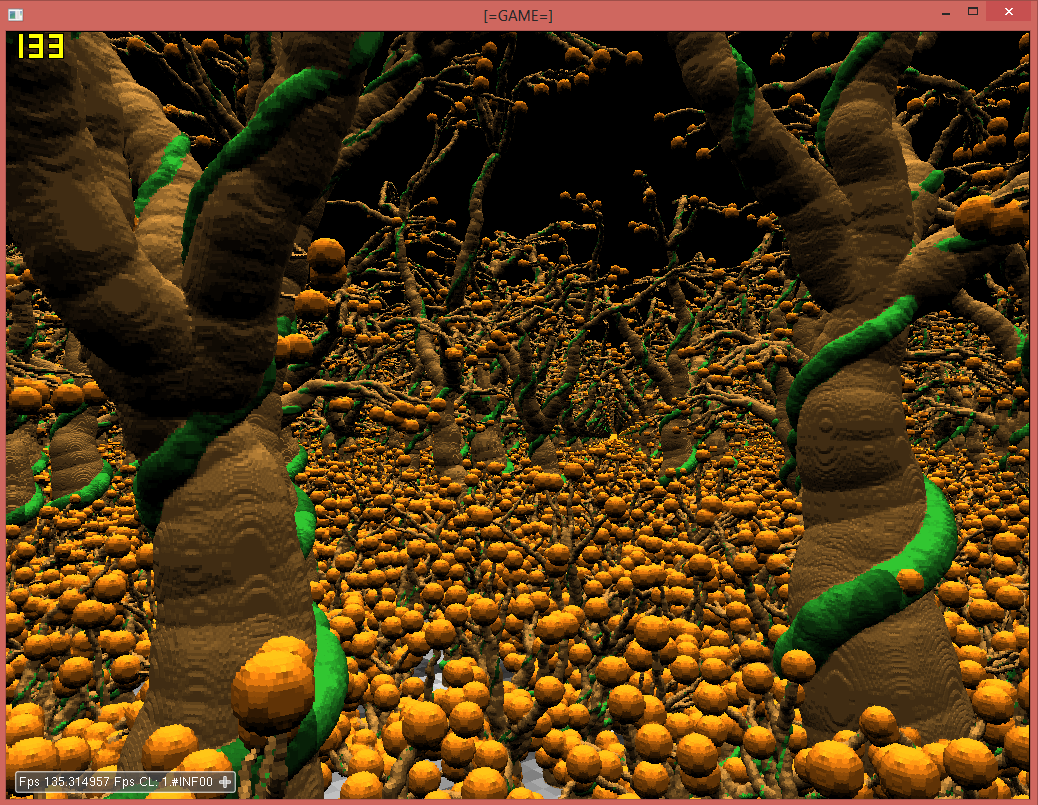Algorithm: A technology I am working on since a while now is to exploit temporal coherence between two consecutive rendered images to speed up ray-casting. The idea is to store the x- y- and z-coordinate for each pixel in the scene in a coordinate-buffer and re-project it into the following screen using the differential view matrix. The resulting image will look as Fig.1.
The method then gathers empty 2x2 pixel blocks on the screen and stores them into an indexbuffer for raycasting the holes. Raycasting single pixels too inefficient. Small holes remaining after the hole-filling pass are closed by a simple image filter. To improve the overall quality, the method updates the screen in tiles (8x4) by raycasting an entire tile and overwriting the cache. Doing so, the entire cache is refreshed after 32 frames. Further, a triple buffer system is used. That means two image caches which are copied to alternately and one buffer that is written to. This is done since it often happens that a pixel is overwritten in one frame, but becomes visible already in the next frame. Therefore, before the hole filling starts, the two cache buffers are projected to the main image buffer.
Limitations: The method also comes with limitations of course. So the speed up depends on the motion in the scene obviously, and the method is only suitable for primary rays and pixel properties that remain constant over multiple frames, such as static ambient lighting. Further, during fast motions, the silhouettes of geometry close to the camera tends to loose precision and geometry in the background will not move as smooth as if the scene is fully raytraced each time. There, future work might include creating suitable image filters to avoid these effects.
Results: Most of the pixels can be re-used using this technology. As only a fraction of the original needs to be raycasted, the speed up is significant and up to 5x the original speed, depending on the scene (see Fig.2 - Fig.4). Resolution for that test was 1024x768, the GPU was an NVIDIA GeForce GTX765M.
Here also two videos showing this technology in action: Video1 Video2
(I uploaded them a while ago)
Finally a few papers for further reading:
Exploiting Temporal Coherence in Ray Casted Walkthroughs
Iterative Image Warping
A Shared-Scene-Graph Image-Warping Architecture for VR: Low Latency versus Image Quality
Three-Dimensional Image Warping on Programmable Graphics Hardware
Accelerating Real-Time Shading with Reverse Reprojection Caching
 |
| Fig.1 Result after basic re-projection |
 |
| Fig.2 Original Version |
 |
| Fig.3 With Re-Projection Enabled + In Motion |
 |
| Fig.4 With Re-Projection Enabled + Standing |

Ideas to solve noisy silhouettes near the camera while fast motion:
AntwortenLöschen1. suppress unwanted pixels with a filter by analyzing the depth values in a small window around each pixel. In experiments it removed some artifacts but not all - also had quite an impact on the performance.
2. (not fully explored yet) Assign a speed value to each pixel and use that to filter out unwanted pixels
3. create a quad-tree-like triangle mesh in screenspace from the raycasted result. the idea is to get a smoother frame-to-frame coherence with less pixel noise for far pixels and let the zbuffer do the job of overlapping pixels. Its sufficient to convert one tile from the raycasted result to a mesh per frame. Problem of this method : The mesh tiles dont fit properly together as they are raycasted at different time steps. Using raycasting to fill in holes was not very simple which is why I stopped exploring this method further
http://www.farpeek.com/papers/IIW/IIW-EG2012.pdf fig 5b
** Untested Ideas **
4. compute silhouettes based on the depth discontinuity and remove pixels crossing them
5. somehow do a reverse trace in screenspace between two frames and test for intersection
6. use splats to rasterize voxels close to the camera so speckles will be covered